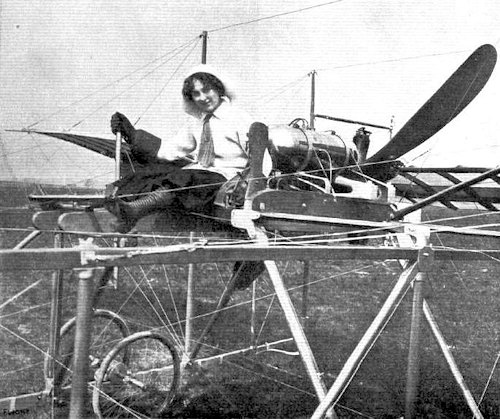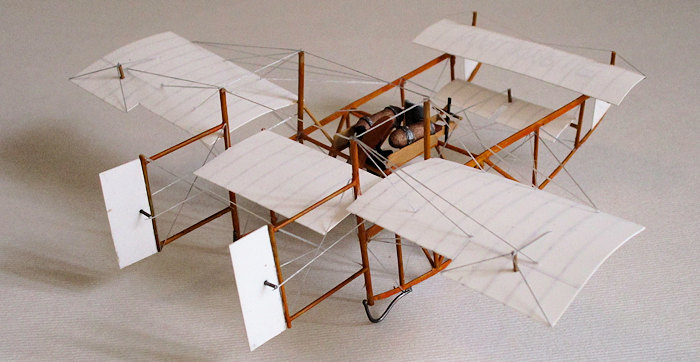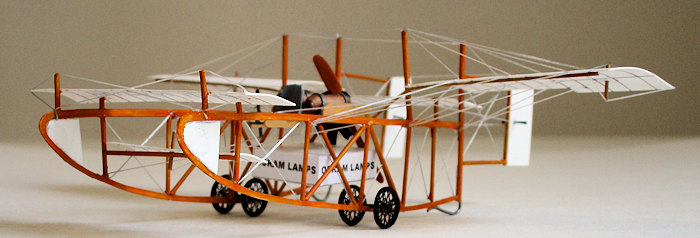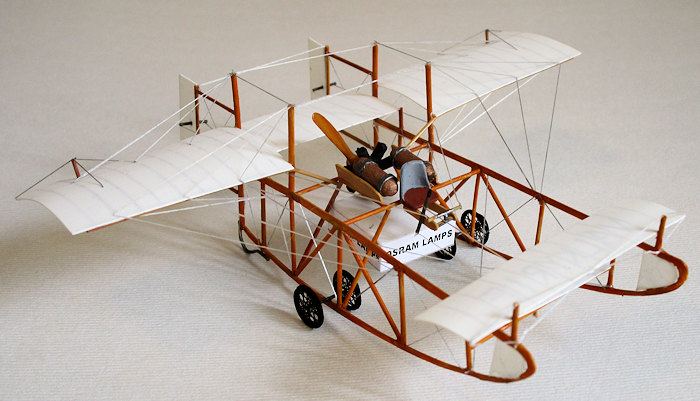
| KIT #: | |
| PRICE: | |
| DECALS: | Home made |
| REVIEWER: | Chris Peachment |
| NOTES: | Made from 10 and 20 thou plastic card, and rod |

| HISTORY |
What you are looking at, dear reader, is the first known instance of an aircraft carrying a commercial payload. As I am sure you recall from your Old Norse lessons in school, the Valkyries were a group of women who decided who would live or die on a battlefield, and who would then escort the souls of the dead to the afterlife in Valhalla.
 The
Valkyrie is also the title of Wagner's second opera in his Ring Cycle, and the
opening music, The Ride of the Valkyries, will be well known to all as the music
played by Robert Duvall in Apocalypse Now as he led his Air Cavalry unit in to
destroy a Vietcong village. So far as I can see none of this has anything to do
with this aircraft, but it is good to know.
The
Valkyrie is also the title of Wagner's second opera in his Ring Cycle, and the
opening music, The Ride of the Valkyries, will be well known to all as the music
played by Robert Duvall in Apocalypse Now as he led his Air Cavalry unit in to
destroy a Vietcong village. So far as I can see none of this has anything to do
with this aircraft, but it is good to know.
The ASL Valkyrie was a canard pusher, with a rear mounted engine, designed by the Aeronautical Syndicate Ltd or ASL in 1910. Unusually for an aircraft of this period, many examples of the type were made, and it was used as a trainer at the ASL flying school, which was the first company to occupy Hendon Aerodrome in North London, where it leased three hangars next to Monsieur Bleriot, who had by now crossed the English channel, although he had had a confusing moment when he became disoriented in cloud and headed back for his starting point in France.
 The
engine was the popular 35hp straight four Green C4, mounted just in front of the
wing leading edge, driving a pusher propeller directly behind. The two
foreplanes, one fixed and the other moveable, were mounted on a pair of widely
spaced mahogany side-frames, each of which had a straight upper boom, and a
curved lower one.
The
engine was the popular 35hp straight four Green C4, mounted just in front of the
wing leading edge, driving a pusher propeller directly behind. The two
foreplanes, one fixed and the other moveable, were mounted on a pair of widely
spaced mahogany side-frames, each of which had a straight upper boom, and a
curved lower one.
The two rudders were mounted on two short booms to the rear. A small area at the front of the side-frames has a fabric covering. A later variant could carry two people side by side and had 50hp Gnome rotary engine. The Type C could seat three people. At least twelve were constructed altogether, the last in early 1912, an unusually high figure for aircraft of this period, and many had dual controls. It was considered tricky to fly, but most of the aircraft produced were used as trainers.
On 4 July 1911 a Valkyrie carried a box of light bulbs made by Osram, the well known British company, from Shoreham to Hove, which was the first commercial air cargo flight in Britain. From Shoreham to Hove is a trip along the south coast of England, a distance of no more than 15 miles.
For this the pilot was paid £100, which was a handsome sum in those days. It is difficult to correct for inflation to give an idea of what that would be in today's money, but many household servants of that period would have earned about £200 as a year's salary. The pilot gave the money to charity.
 Miss
Eleanor Trehawke Davies, an early flying enthusiast, chartered a Valkyrie, to
fly her from Hendon to Brighton and back, a daunting distance of perhaps 60
miles. The flight took only two days, which was probably some kind of record.
She
later became the first air passenger between London and
Paris. She can be seen in one photo, posing in the pilot's seat, clad in a
collar and tie, and showing a daring amount of stocking, the brazen hussy. The
famous pioneer Claude Grahame-White, the man who made the first night flight,
can also be seen in the Valkyrie, in one early photo, smoking a cigarette while
a postman behind him loads the aircraft up with a mailbag.
Miss
Eleanor Trehawke Davies, an early flying enthusiast, chartered a Valkyrie, to
fly her from Hendon to Brighton and back, a daunting distance of perhaps 60
miles. The flight took only two days, which was probably some kind of record.
She
later became the first air passenger between London and
Paris. She can be seen in one photo, posing in the pilot's seat, clad in a
collar and tie, and showing a daring amount of stocking, the brazen hussy. The
famous pioneer Claude Grahame-White, the man who made the first night flight,
can also be seen in the Valkyrie, in one early photo, smoking a cigarette while
a postman behind him loads the aircraft up with a mailbag.
Four aircraft were given to the War Office to promote the idea of military aviation in Britain, which was timely, what with 1914 only three years away.
| CONSTRUCTION |
 There
are some excellent plans on the internet, and it didn't take very much scrutiny
of these to realise that construction would be straightforward, bar the two side
frames. Since the nose of each is one continuous curve from upper to lower boom,
I decided to cut each of these in one piece from 20 thou card. Naturally they
warped a little, so I called them to order with a heavy book on top of them
overnight. After that, they behaved.
There
are some excellent plans on the internet, and it didn't take very much scrutiny
of these to realise that construction would be straightforward, bar the two side
frames. Since the nose of each is one continuous curve from upper to lower boom,
I decided to cut each of these in one piece from 20 thou card. Naturally they
warped a little, so I called them to order with a heavy book on top of them
overnight. After that, they behaved.
The cross struts are easily done from the plan, and then the two side frames are joined by surprisingly few struts, just two in a ladder shape in the cockpit and engine area, with some diagonal braces.
| COLORS & MARKINGS |
The four wing kingposts were also added here, as were the tail booms. The whole structure was given a coat of wood brown, and then some clear flat orange from the Vallejo range. This is good stuff, unlike the Tamiya Clear Orange which is thick and has a nasty tendency to clump. Since mahogany is a dark wood, I gave it a couple of coats. The side frame rigging is best done at this point, and is a simple diagonal back and forth affair.
|
MORE CONSTRUCTION |
 The
wings, foreplanes, and rudders are all made from 10 thou card, scored on one
side with a dead biro to represent ribs, and then taped around paint brushes of
varying diameter to get the right camber. The upper fixed foreplane has the word
“Valkyrie” printed underneath, which I did with a felt tip pen and ruler. It can
just be seen on the upper side, albeit in reverse, and has the happy bonus of
making the fabric look transparent.
The
wings, foreplanes, and rudders are all made from 10 thou card, scored on one
side with a dead biro to represent ribs, and then taped around paint brushes of
varying diameter to get the right camber. The upper fixed foreplane has the word
“Valkyrie” printed underneath, which I did with a felt tip pen and ruler. It can
just be seen on the upper side, albeit in reverse, and has the happy bonus of
making the fabric look transparent.
The lower foreplane has a section cut out of the middle to clear the control wires, which run from a control horn to the side-mounted joystick. The centre section of wing rests quite easily between kingposts and frames. But the two outer wings are trickier. It is best to give them a main spar at the leading edge, with an overhang which bends downwards to become a brace to the main frames. Watch out for the slight dihedral.
The pilot's seat is attached to the engine frame, and needs a simple wooden frame ahead of it to support the rudder pedals. The joystick is side-mounted, just like your modern F-16. The pilot's view on the Valkyrie is even better than the F-16's, given that he has a clear visual sweep of 360 degrees in horizontal and vertical planes. There is no modern aircraft that can do better.
 The wing
rigging goes from various points on the wing frame to the four kingposts, and
also to the side frames. Rigging, as usual, was done with elastic thread,
coloured silver with a gel pen, and attached with small drops of superglue gel,
applied with a sharpened toothpick. For some places, it is useful to sharpen the
toothpick to a chisel point, rather than a needle.
The wing
rigging goes from various points on the wing frame to the four kingposts, and
also to the side frames. Rigging, as usual, was done with elastic thread,
coloured silver with a gel pen, and attached with small drops of superglue gel,
applied with a sharpened toothpick. For some places, it is useful to sharpen the
toothpick to a chisel point, rather than a needle.
The fuel tanks are lengths of sprue, painted copper, with some gunmetal bands around them. Photos show that they came in various shapes and sizes, and varied between one and two in number. The Gnome engine and prop came from the spares box. The smallish wheels have tires made of solder, and wire spokes from the excellent Eduard etched metal wheel set. The two tail skids on each side were made from copper wire, bent with needle-nose pliers and painted gunmetal.
Finally the coup de grace, the defining moment, that thing which gives a model some distinction: a box of Osram light bulbs. The box was made from thin card, and the Osram logo was printed out in 6 point Gill Sans capitals and attached to each side. It was slung under the pilot, using minute bungee cords to minimise vibration to the light bulbs. Inside the box are a two dozen tiny electric light bulbs, a bill of lading and an invoice for £100 sterling. Alas none of it cannot be seen.
| CONCLUSIONS |
So there you have the first ever commercial cargo aircraft. A box of light bulbs might not seem like much, but from that moment in time, it is only a matter of 80 years before you arrive at the C5 Galaxy and the mighty Antonov An-225, which has a takeoff weight in excess of 640 tons. And pound for pound, the cost of transporting its payload is probably much the same as it was in 1911.
| REFERENCES |
http://flyingmachines.ru/Site2/Crafts/Craft28489.htm
http://airliner.narod.ru/1cargo/asl-valkyrie-osam.htm
http://www.aviastar.org/air/england/aeronautical_valkyrie.php
http://www.airwar.ru/enc/law1/valkyrie.html
31 May 2016
Copyright ModelingMadness.com If you would like your product reviewed fairly and
fairly quickly, please
contact
the editor or see other details in the
Note to
Contributors.